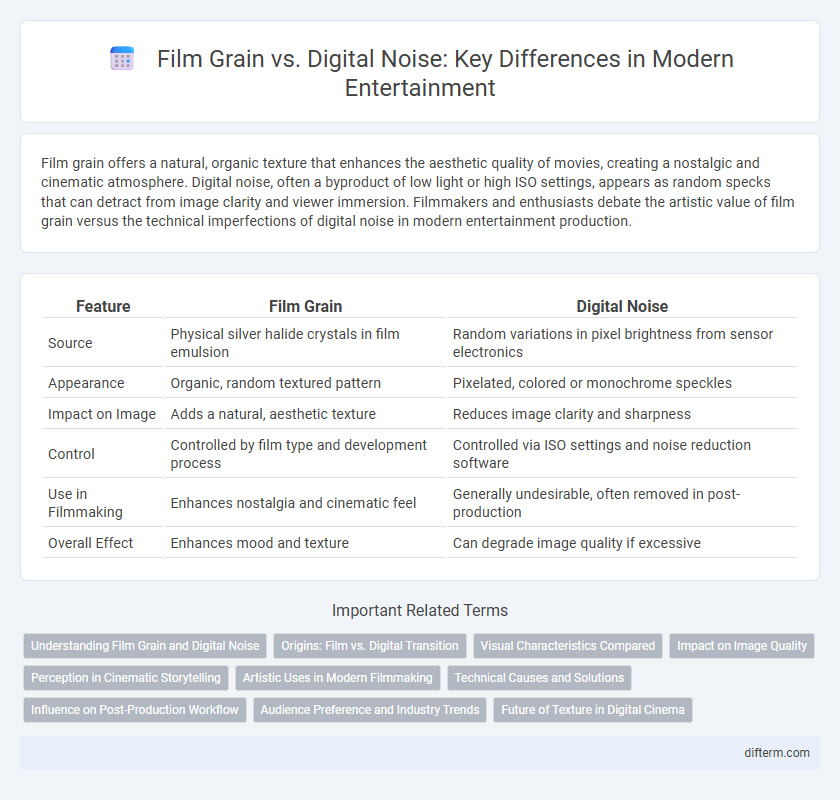Film grain offers a natural, organic texture that enhances the aesthetic quality of movies, creating a nostalgic and cinematic atmosphere. Digital noise, often a byproduct of low light or high ISO settings, appears as random specks that can detract from image clarity and viewer immersion. Filmmakers and enthusiasts debate the artistic value of film grain versus the technical imperfections of digital noise in modern entertainment production.
Table of Comparison
| Feature | Film Grain | Digital Noise |
|---|---|---|
| Source | Physical silver halide crystals in film emulsion | Random variations in pixel brightness from sensor electronics |
| Appearance | Organic, random textured pattern | Pixelated, colored or monochrome speckles |
| Impact on Image | Adds a natural, aesthetic texture | Reduces image clarity and sharpness |
| Control | Controlled by film type and development process | Controlled via ISO settings and noise reduction software |
| Use in Filmmaking | Enhances nostalgia and cinematic feel | Generally undesirable, often removed in post-production |
| Overall Effect | Enhances mood and texture | Can degrade image quality if excessive |
Understanding Film Grain and Digital Noise
Film grain consists of random optical texture particles in photographic film, creating an organic, textured look valued for its aesthetic and nostalgic qualities in movies. Digital noise appears as random speckles or static in digital images, often due to low light or high ISO settings, resulting in a less desirable visual distortion. Understanding the distinction between film grain and digital noise helps filmmakers and photographers choose the appropriate visual effect for mood, atmosphere, and authenticity in their work.
Origins: Film vs. Digital Transition
Film grain originates from the crystalline silver halide particles embedded in photographic film emulsions, creating a textured, organic visual effect inherent to analog film processing. Digital noise stems from electronic interference and sensor limitations in digital cameras, often manifesting as random speckles in low-light conditions due to the amplification of electrical signals. The transition from analog to digital filmmaking marked a significant shift in aesthetics and technology, moving from the natural randomness of film grain to the algorithmically processed patterns of digital noise.
Visual Characteristics Compared
Film grain exhibits a natural, organic texture with irregular patterns that enhance the cinematic atmosphere, while digital noise appears as random, often harsh pixel variations disrupting image clarity. Film grain's distribution is typically uniform and subtle, preserving image details, whereas digital noise can be uneven and more distracting, especially in low-light conditions. Understanding these visual characteristics helps filmmakers and photographers choose the ideal aesthetic for storytelling or realistic representation.
Impact on Image Quality
Film grain offers a textured, organic quality that enhances the aesthetic depth and authenticity of cinematic images, often appreciated for its subtle randomness and warmth. Digital noise, by contrast, appears as unwanted pixelation or color distortion that detracts from image clarity, especially in low-light conditions or with high ISO settings. The impact on image quality is significant, as film grain can enrich visual storytelling, while digital noise generally degrades sharpness and overall viewer experience.
Perception in Cinematic Storytelling
Film grain enhances cinematic storytelling by adding a tactile, organic texture that evokes nostalgia and emotional depth, often perceived as a hallmark of authentic, immersive visuals. Digital noise, typically seen as a technical artifact, can distract viewers and diminish the perceived quality of the image, reducing emotional engagement. Filmmakers strategically use film grain to amplify atmosphere and mood, leveraging its aesthetic value to support narrative authenticity, whereas digital noise is usually minimized to preserve visual clarity.
Artistic Uses in Modern Filmmaking
Film grain imparts a textured, organic aesthetic favored by filmmakers seeking to evoke nostalgia or emphasize mood, as seen in works like "Joker" and "The Lighthouse." Digital noise, while often considered a flaw, can be artistically manipulated to create gritty realism or experimental visuals, utilized in indie films and music videos for raw authenticity. Contemporary directors blend film grain and digital noise to balance vintage charm with modern clarity, enhancing storytelling through visual tone.
Technical Causes and Solutions
Film grain originates from the physical silver halide crystals in analog film emulsions, creating a natural texture during chemical development, while digital noise results from electronic interference and sensor limitations in low-light conditions. Film grain can be controlled through varying film types and development processes, whereas digital noise reduction involves advanced algorithms like multi-frame noise reduction and sensor design improvements. Effective noise management in digital imaging relies on balancing ISO settings, sensor sensitivity, and post-processing software enhancements to minimize unwanted artifacts without compromising detail.
Influence on Post-Production Workflow
Film grain adds organic texture that enhances the visual depth of footage, requiring careful grade adjustments during post-production to maintain its subtlety and artistic intent. Digital noise, often seen as an undesirable artifact, demands extensive noise reduction techniques that can reduce image sharpness and limit color grading flexibility. Understanding the impact of film grain versus digital noise allows editors to optimize workflows for either preserving analog aesthetics or achieving cleaner digital imagery.
Audience Preference and Industry Trends
Film grain often appeals to audiences seeking nostalgia and artistic authenticity, while digital noise tends to be viewed as a technical flaw in digital cinematography. Industry trends show a resurgence of film grain in post-production to enhance texture and emotional depth, driven by filmmakers aiming to replicate classic aesthetics in digital formats. Audience preference increasingly favors the intentional, stylized presence of film grain over the random and distracting nature of digital noise.
Future of Texture in Digital Cinema
Film grain and digital noise serve distinct roles in shaping the texture of digital cinema, with film grain often appreciated for its organic, unpredictable patterns that add warmth and depth to visuals. Advances in digital technology are enabling filmmakers to replicate authentic film grain digitally, enhancing the tactile feel without compromising image clarity. Future developments in AI-driven texture synthesis promise to further blur the line between natural film grain and artificial digital noise, offering creative control over cinematic aesthetics.
Film grain vs Digital noise Infographic

 difterm.com
difterm.com